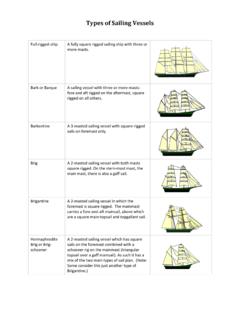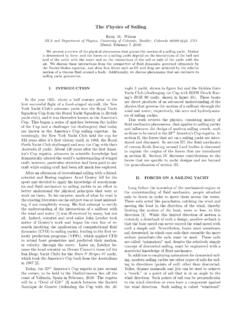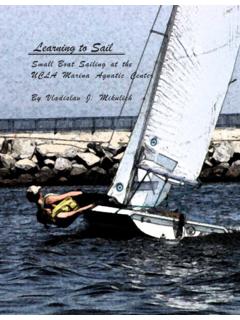Transcription of Basic Sailing Course Student Syllabus
1 24707 Dana Drive, Dana Point, CA Sailing CourseStudent SyllabusWe Can Teach You How to Sail and Keep You Sailing !Mark W. HoweDirector of Education ProgramsName Class Start Date031918 Table of ContentsPart I - Student Syllabus Page Outline 2 Terms and Conditions of Enrollment 3 Terminology - Parts of a Boat 4-5 Terminology - Sailing 6 Sails and Rigging 7 Rigging and Parts of a Sail 8 Points of Sail 9 Safety Devices and Fire Emergency Procedures 10 Man Overboard Recovery Techniques 11 Important
2 Checklists for Aventura Boat Operation 12-14 Undocking and Docking Procedures 15-16 Maneuvering Under Power 17 Rules of the Road 18 Navigation Lights, Fog Signals and Aids to Navigation 19 Marine Systems - Diesel Engines 20 Marine Systems - Alcohol Stove and Marine Head 21 Marine Radio Procedures 22 Stopping a Boat Under Sail 23 Part II - Student WorkbookTake-home Quizzes and Worksheets 24-31 AppendixHarbor Chart 32 Sailing Equipment Operations Checklist 33(To be used during dockside orientation) Sailing Lab Procedures 34 Take-home Quiz Answers 35 Marine Systems - Diesel Engine Cooling System 36 Basic Sailing Course Outline 2 Lecture 1 Sailing Terminology Principles of Sail Points of Sail Sailing Maneuvers (Take-home Quiz # 1A&B)Lecture 2 Safety at Sea Aventura Safety Checklists Man Overboard Procedures Emergency Procedures Maneuvering Under Power Docking Basic Knots (Take-home Quiz #2A&B)
3 Lecture 3 Rules of the Road Marine Systems Maintenance and Troubleshooting Engines Inboard, Outboard, Diesel Marine Stoves Marine Heads Marine Radio Procedures (Take-home Quiz #3)Lecture 4 Rules of the Road Review Heavy Weather Sailing (Survival) Basic Anchoring Final Examination (at your convenience) Basic Sail 1 Dock Side Boat Orientation Setting and Dousing Sails Engine Operation Basic Knots Reefing Demonstration and Practice Basic Sail 2 Getting Underway Sailing Maneuvers Coming About Gybing Man Overboard Basic Sail 3 Maneuvering Under Power Docking and Undocking Sailing Review Rules of the Road Drills Basic Sail 4 (Final Exam)
4 Demonstration of Proficiency in all areas Anchoring Demonstration Please Fill in Your Course Schedule BelowLecture Dates1 _____2 _____3 _____4 _____Labs - On the Water Sail Dates1 _____2 _____3 _____4 _____LecturesLabsNew Members OrientationAventura Policies & Procedures Charter Certification RequirementNew Members Orientation Date:_____Terms & Conditions of Enrollment 3 Terms and Conditions of Enrollment and Registration Policies Enrollment is for a specifically scheduled class session with meetings agreed upon during application.
5 Refund/cancellation requests must be received no later than 48 hours prior to the first day of the class or be subject to a 50% penalty charge. Times, dates, and locations are subject to change without notice. Most students are able to learn to operate a vessel during the normal class schedule of four lectures and four lab practice sessions. Students sign up for lab times based on schedule and convenience. If a Student is unable to attend the scheduled sessions during a class, make-up labs will be available. If make-up labs are scheduled in advance there will be no charge provided they are made up in the next available class offering or as arranged.
6 There will be no charge for additional lectures or the Lecture/Lab I. For students needing additional labs whether for reasons of failure to show up for a scheduled lab or needing more practice to be able to operate a vessel, extra lab sessions will be available. These refresher/make-up labs will be at a special alumni price per session and are highly recommended. Changes to scheduled labs may be made in person during class or by phone to the Aventura completion of Course requirements may be extended 30 days (or until completion of the following class session) to allow for agreed upon makeup work to be completed.
7 Students failing to successfully complete the Course within the 30 day grace period, including a passing score on the written examination, will be dropped. Dropped students will be required to pay the scheduled rate for all subsequent makeup instruction, as will students failing to attend class for reasons of personal convenience or neglect. Members successfully completing all coursework according to the above will receive certification for chartering boats or other recognition appropriate to the Course . Members failing to maintain skills by chartering or actively participating in Sailing programs within a reasonable length of time may be required to recertify for the safety of their vessel and crew.
8 This will be at least a 9 month who successfully complete the Course and desire to join the Aventura Sailing Association may do so without payment of the certification fee if they act within 30 days of the completion of their coursework. Otherwise it will be necessary to go through certification as with any new member. Nonmembers failing to complete the Course in the time allotted will not receive any certification and will need to re-apply for certification if desired and pay any necessary - Parts of a Boat 4 HullDeck and Cockpit Deck Cockpit Lifeline & Stanchion Rail (Toe Rail)Bow Pulpitand Anchor with RollerKeel Full with Lead ballastKeel Full Keel - ShallowFin Keel - Deep Shoal Draft = (Shallow)Stern Pulpit Helm & WheelRudderEmergency Tiller Emergency Tiller Scupper (Drain)
9 Terminology - Parts of a Boat 5 Cabin V-berth CockpitAnchoring Equipment Ground Tackle Rode: Rope & ChainScope: Ratio of Rode to DepthFender (Rubber bumper)Lazarette (Storage)Block (Pulley)Terminology - Sailing 6 DirectionA boat sails by the apparent wind, not the true WindHigherFall OffWindwardLeeLeewardWindwardLeeLeewardW eatherHead UpWind DirectionDown Wind45 30 Apparent14 KTSTrue10 KTSA pparent6 KTS4 KTS5 KTSTrue Wind vs. Apparent Other Terms Raise/Douse Sails Luff (verb) Luffing Way, Way On (motion thru the water) Weather Helm (turns into the wind) Draft (depth of something)Boat Draft vs Sail Draft Tenderness/Heel -15 -20 maximum Ease, Ease off (scootch) vs.
10 Slack, Release Winches turn clockwise (2 if by hand; 4 if by crank)ClinometerWinchAbeamDead AheadDead AsternPortStarboard AbeamPort BowStarboard BowStarboard QuarterPort QuarterPoint System: 32 points = 360 Running Lights Graphic10 and Rigging 7 Main & JibJib Sail Sizes: % is the distance from the mast forward. Genoa Jib = 130-180% Lapper Jib = 110-120% Working or Storm Jib = Less than 100% Stays Forestay or Headstay & Backstay Holds Mast Front To BackShrouds Upper vs Lower Holds Mast Side to Side, Diagonals (at an angle)Spreaders Cross TreesChainplate Anchoring Points In HullTurnbuckles Adjusting ScrewsHalyards andHalyard WinchesRaising & Lowering Sails (Main - Starboard)Sheets andSheet Winches Letting Sail Out or Pulling it (Rope Guide)









